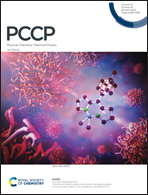Non-covalent interactions with inverted carbon: a carbo-hydrogen bond or a new type of hydrogen bond?†
Abstract
In contrast to the conventional and non-conventional non-covalent interactions (NCIs) such as hydrogen bond and carbon bond, a bidirectional NCI without π- and/or lone pair(s) of electrons has never been reckoned until the present report, which confirms that this type of NCI can be possible with the involvement of mostly σ-electrons. This newly discovered NCI can be coined as carbo-hydrogen bond (CH-bond) based on its resemblances with both carbon bond (C-bond) and hydrogen bond (H-bond) or Ci:::H interaction. A detailed crystal structure analysis of 5-cyano-1,3-dehydroadamantane, which contains inverted carbon atoms (Ci) and Ci–Ci σ-bond, gave us the opportunity to unveil the very first existence of the Ci:::H interaction. With the aid of several quantum chemical calculations, we came to the conclusion that molecules carrying Ci–Ci σ-bonds are capable of forming CH-bonds with main group hydrides through the σCi–Ci → σ*X–H (H-bond) and σX–H → σ*Ci–Ci (C-bond) orbital interactions. The interaction energy can be as much as −31.27 kJ mol−1, which is comparable to that of the water dimer and it is also one of the prominent attractive forces that hold the molecules together in the crystal structure, can be responsible for the enzymatic activity of cytochrome P411-E10 and the formation of non-covalent organic framework (NCOF) with trigonal and tetragonal CH-bond connectors.



 Please wait while we load your content...
Please wait while we load your content...